
ATHLETES ARE PRONE TO A WIDE RANGE OF INJURIES, primarily because of high physical demands and repetitive movements in sports, whether recreational or professional. While conventional medical treatments, such as physical therapy, medications, and surgery, are commonly used to treat sports injuries, chiropractic care has emerged as a valuable complementary approach.
Chiropractic treatment focuses on the musculoskeletal system, particularly the spine, but also addresses issues in the joints and muscles, making it a versatile and effective treatment option for sports-related injuries. This article explores the role of chiropractic care in sports injuries and rehabilitation, emphasizing its benefits for injury prevention, pain management, and recovery.
Sports injuries can occur because of overuse, trauma, improper training techniques, or insufficient warm-up and stretching. Some of the most common sports injuries include:
1. Sprains and strains: Sprains are injuries to ligaments, while strains involve damage to muscles or tendons. Both are common in sports that involve sudden movements, twisting, or contact, such as basketball, soccer, and football.
2. Tendonitis: Repetitive stress on tendons, often seen in tennis players or runners, can lead to inflammation and pain, commonly known as tendonitis.
3. Dislocations: A dislocation occurs when a bone is forced out of its joint. Contact sports, such as rugby and football, often result in shoulder, elbow, or knee dislocations.
4. Shin splints: This is a common injury in runners, resulting from stress on the tibia bone and the muscles around it. It typically occurs because of overuse or improper footwear.
5. Concussions: Head injuries, especially in high-impact sports, can lead to concussions. While chiropractic care does not directly treat concussions, it can help manage symptoms related to the neck and spine that may contribute to discomfort following a head injury.
6. Herniated discs: High-impact sports or weightlifting can cause disc injuries in the spine, leading to pain, weakness, and limited mobility.
Chiropractic care revolves around the belief that the body can heal itself when the spine and joints are in proper alignment. Misaligmnents can result from trauma or repetitive strain, leading to pain, inflammation, and restricted movement. Manual adjustments, soft tissue therapies, and rehabilitation exercises to restore alignment and enhance the body’s natural healing process.
Joint mobilization/manipulation helps relieve nerve pressure, reduce inflammation, and improve mobility. For athletes, spinal adjustments can alleviate back pain, neck pain, and other joint issues, providing immediate relief and enhancing overall performance. Extremity joint manipulation can help restore range of motion and reduce stiffness, which is essential for athletes looking to return to their sport quickly and effectively.
Soft tissue therapy focuses on the muscles, tendons, and ligaments that support the skeletal system. Techniques such as myofascial release, trigger point therapy, and massage are used to relieve muscle tension, break down scar tissue, and promote blood flow to injured areas. This holistic approach aids in reducing pain and speeding up the recovery process.
For athletes, soft tissue therapy is particularly beneficial because it addresses muscle imbalances and tightness that may contribute to injury. By improving the flexibility and strength of the muscles surrounding the joints, chiropractic care helps reduce the risk of future injuries.
Rehabilitation exercises play a crucial role in restoring an athlete’s strength, flexibility, and overall function, designing personalized exercise programs tailored to the athlete’s specific needs, focusing on strengthening weakened muscles, improving joint stability, and correcting movement patterns.
Rehabilitation exercises are essential for preventing reinjury and ensuring that the athlete can safely return to their sport. These exercises often include stretches, balance training, resistance exercises, and mobility drills designed to improve overall athletic performance and reduce the likelihood of future injuries.
Non-Invasive and Drug-Free
One of the primary advantages of chiropractic care is that it offers a noninvasive and drug-free approach to treating sports injuries. Many athletes prefer this method because it avoids the potential side effects of medications or risks associated with surgery. Chiropractic care emphasizes natural healing, allowing the body to recover without relying on painkillers or anti-inflammatory drugs.
Pain Relief and Inflammation Reduction
Chiropractic adjustments help reduce inflammation by promoting proper alignment and restoring normal function to the affected joints. This reduction in inflammation leads to significant pain relief, which is crucial for athletes looking to return to their sport as quickly as possible. By addressing the underlying cause of pain, chiropractic care provides long-lasting relief rather than just masking symptoms.
Improved Mobility and Flexibility
Restoring mobility and flexibility is key to effective rehabilitation. Improving the range of motion in joints and reducing muscle tension allows athletes to move more freely and perform at their best. Whether it’s a golfer recovering from a back injury or a soccer player with a sprained ankle, restoring optimal movement patterns is essential.
Enhanced Performance
In addition to treating injuries, chiropractic care can also enhance athletic performance by ensuring that the spine and joints are properly aligned. Proper alignment improves posture, balance, and coordination, allowing athletes to perform at their peak. Many professional athletes, including football players, golfers, and Olympic competitors, use chiropractic care to recover from injuries and optimize their physical performance.
Preventative Care for Athletes
Chiropractic care is not only beneficial for treating existing injuries but also for preventing future injuries. Regular adjustments and soft tissue therapies can help maintain joint health, reduce muscle imbalances, and correct improper movement patterns. By keeping the musculoskeletal system in optimal condition, athletes can reduce the risk of overuse injuries and enhance their overall resilience.
“By improving the flexibility and strength of the muscles surrounding the joints, chiropractic care helps reduce the risk of future injuries.”
Chiropractic care plays a vital role in treating and rehabilitating sports injuries. Through spinal and joint adjustments, soft tissue therapy, and rehabilitation exercises, chiropractors help athletes recover from injuries, manage pain, and prevent future issues.
Whether an athlete is recovering from a traumatic injury or dealing with chronic pain, chiropractic care offers a natural, noninvasive approach that can enhance recovery and improve performance. As more athletes recognize the benefits of chiropractic care, it will likely become an increasingly integral part of sports injury rehabilitation and prevention.
Dr. Kurt A. Juergens attended Brigham Young University and graduated from Texas Chiropractic College. He owns Juergens Chiropractic & Sports Rehab Center in Houston, Texas, where he continues to treat high school and professional athletes from all fields worldwide. He has been a member of the sports medicine team for the United States Olympic Track and Field Trials, the NCAA Track and Field Championships, the ATP’s Tennis Masters Cup, and the U.S. Clay Court Championships. As a Foot Levelers Speakers Bureau member, Dr. Juergens travels the country speaking on chiropractic topics with a focus on sports medicine. See upcoming continuing education seminars with Dr. Juergens and other Foot Levelers Speakers at www.footlevelers.com/seminars
 View Full Issue
View Full Issue






